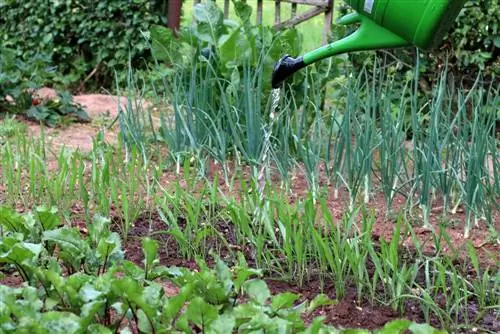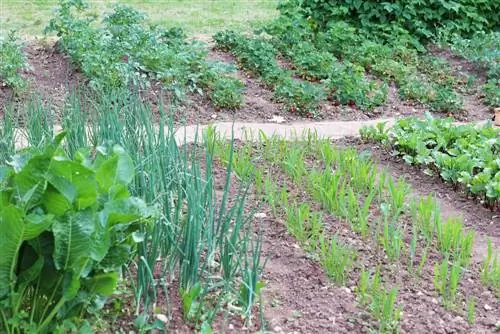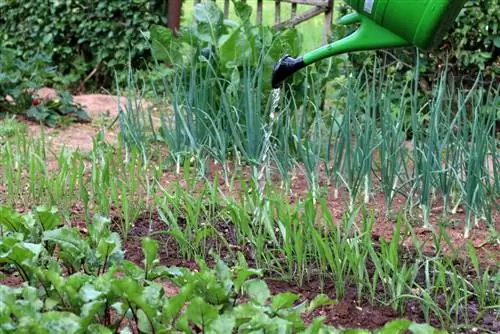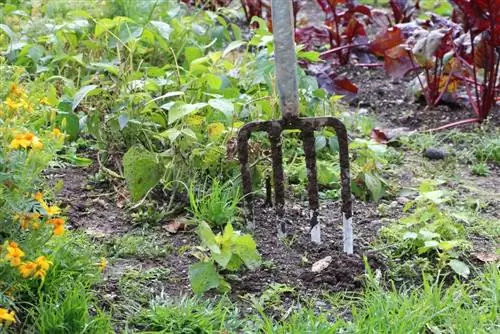- Author admin [email protected].
- Public 2023-12-17 03:39.
- Last modified 2025-01-24 12:45.
We always read about vegetables from the supermarket being contaminated with pesticides or other pollutants. It's no wonder that some people think about growing their own vegetables just to be on the safe side. In order for this to actually be worthwhile and produce a reasonable return, you absolutely need your own garden. In fact, interest in gardening and becoming a small-scale vegetable farmer has increased significantly in recent years. With a little know-how it's not that difficult.
Requirements
The dream of having your own vegetable garden is one thing, realizing it is something completely different. First of all, you need land. Although some vegetables can also be grown on the balcony, the yield there is usually limited. Under no circumstances is the balcony garden enough to support an entire family. So space is required. Anyone who owns their own house is usually fine. There is usually always some open space for a few beds on the property belonging to the house. However, if you are not a homeowner, you need alternatives. These can be found, for example, in an allotment garden or an alternative garden cooperative, where you can rent a plot of land. However, demand is very high, which is why it is often not possible without a certain waiting time. Maybe you can find a suitable small plot of land elsewhere that you can use for a garden. However you get the necessary space, it should definitely meet the following requirements:
- Minimum size of 50 square meters, 100 square meters is better
- soil uncontaminated by poisons and pollutants
- easy accessibility, even with a vehicle with a trailer, for example to deliver compost
- As sunny a location as possible, under no circumstances should the area be in permanent shade
- own water supply on the property
The last two points in particular play a big role. Vegetables absolutely need light and water to thrive. A garden in the shade of a large apartment building therefore makes just as little sense as one without a water connection. Above all, the water problem should not be underestimated - regardless of whether the garden is behind your own house or on a leased property. Anyone who has to lug heavy watering cans from the cellar to the garden several times a day in a hot summer will quickly appreciate a direct water connection.
Planning
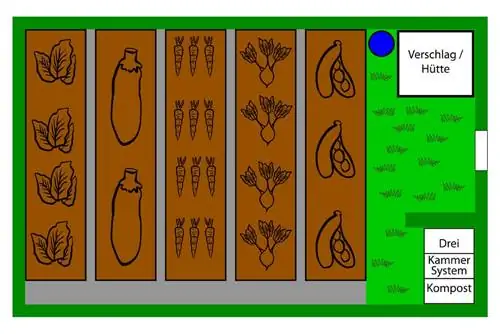
Once a suitable area has been found, the garden can be planned. Vegetables are best grown outdoors in beds. Although you could, at least theoretically, simply stick the seeds into the ground on your property, the harvest success would then be limited. Beds are therefore not just a whim of order fanatics, but also guarantee sensible growth of plants and, above all, make essential gardening work easier. A vegetable garden is therefore hardly conceivable without beds. In addition, you should also plan a location for composting garden waste and a small hut or at least a shed for garden tools in the area available.
The beds must always be planted in the sunniest place on the property. Of course, their number depends on how many types of vegetables you want to grow and what yield is important to you. Ultimately, of course, it also depends on how much space is available. An ideal bed is around five to six square meters in size. The length of the individual beds plays a minor role. Their width, however, should not exceed 1.20 meters so that the plants in the middle of the bed can still be easily reached from the sides. The beds are flanked by small paths that ensure access without having to climb directly into the bed.
Tip:
It's better to plan the entire vegetable garden and especially the beds a little smaller at the beginning. A garden is a lot of fun, but it also requires a lot of work - ten square meters of vegetable beds require around 30 minutes of maintenance per week.
Before you start creating the garden, it's best to make a small plan on which the locations of the beds, the compost facility and the shed are marked. The required paths and, if necessary, a windbreak for the beds should not be forgotten.
Creating beds
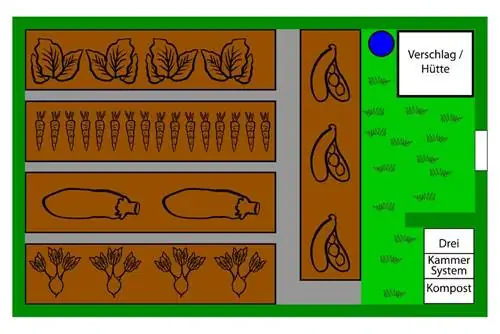
The number of beds depends on two factors - the area available and the amount of vegetables you want to grow. In order to be able to supply a family of four with enough vegetables over the summer, for example, you need a bed area of around 150 square meters in total. As a rule, you will and will have to get by with significantly less. Regardless of this, you should take the following area information into account when creating the beds.
- per bed around six square meters (1.20 by five meters)
- one square meter (0.20 by five meters) per path between the beds
- for an access path at the head of the beds a minimum width of 50 centimeters
Before you start creating the individual beds, the entire area should be dug up to about a spade depth. If the soil is particularly rich in clay, we recommend digging thoroughly to a depth of two spade lengths. Any roots and weeds that appear must be carefully removed. A very clayey soil has very low permeability. To avoid waterlogging and make it easier for plants to root, the permeability should be increased by mixing coarse sand into the soil.
It should be a layer of sand about ten centimeters high. It's best to first apply it to the area in a closed layer and then mix it in with a rake or a cultivator. Finally, humus is applied. Garden compost is ideal for sandy soils. Loamy soils contain leaf humus. Once this has been done, the beds can be marked out according to the dimensions and the earth can be compacted on the planned paths.
Create space for compost
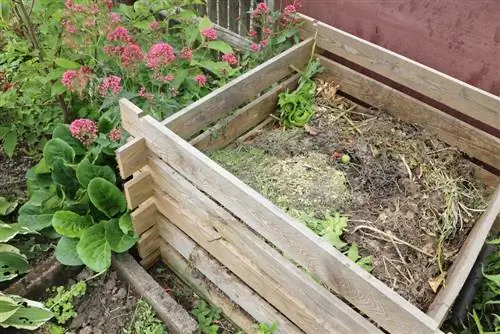
Compost is a natural fertilizer for plants that provides important nutrients. Over the course of a year, a lot of vegetable garden waste such as leaves, stems, roots or grass is produced, which can be wonderfully turned into compost. It is therefore essential for every garden to have its own composting area - also because garden waste can be disposed of in a completely natural way. You can quickly build the necessary composter yourself. For a system with the recommended three-chamber system you need:
- four wooden posts that form the corners of the complex
- four panels made of wood, plastic or metal as side parts
- two panels made of wood, plastic or metal as dividers for the interior
The place where the composter will stand must not be sealed. This makes it possible for worms and other animals to get to the garden waste from below and thus contribute to its decomposition. In addition, any liquid released during composting can drain away easily. The three chambers of the composter each represent a different composting status. Fresh garden waste goes into the first chamber. Once these have decomposed roughly, they are transferred to the second chamber. This frees up space for new waste. The finished compost can then be removed from the third chamber and used to fertilize the plants.
Shack
Gardening can hardly be done without appropriate tools and equipment such as a spade, a shovel, a rake or even secateurs. It is advisable to store these equipment directly in the garden. On the one hand, you always have everything you need at hand. On the other hand, you save yourself the often tedious transport there and away. A small hut or at least a lockable shed is suitable as a storage location. Garden sheds made of wood or metal can be purchased as kits from garden retailers. You can also buy crates there. However, you can also build a shed yourself relatively easily from boards and wooden planks.
Getting started
Once the future vegetable garden has been laid out, it's time to fill it with plants. Basically, all types of vegetables that grow under our climatic conditions are suitable for this - regardless of whether you prefer to sow seeds or put young plants in the ground. For starters, however, the types of vegetables that grow relatively quickly are particularly recommended. These include, among others:
- all salads
- Kohlrabi
- Carrots
- Radish
- Beans
- Peas
- Zucchini
These varieties not only have the advantage that young gardeners can see success very quickly - they are also relatively undemanding and easy to care for. If, on the other hand, you are less concerned about speed and have a little more patience, you should think about planting only potatoes in all the beds first. The coarse tubers have the invaluable advantage of permanently loosening the soil. In addition, their lush leaf growth prevents weeds from spreading on the surface. Potatoes are something like the ideal start for the fresh beds. They condition the beds to a certain extent for later and at the same time provide plenty of garden waste that can be wonderfully composted. And honestly: who can claim to eat potatoes from their own garden?

